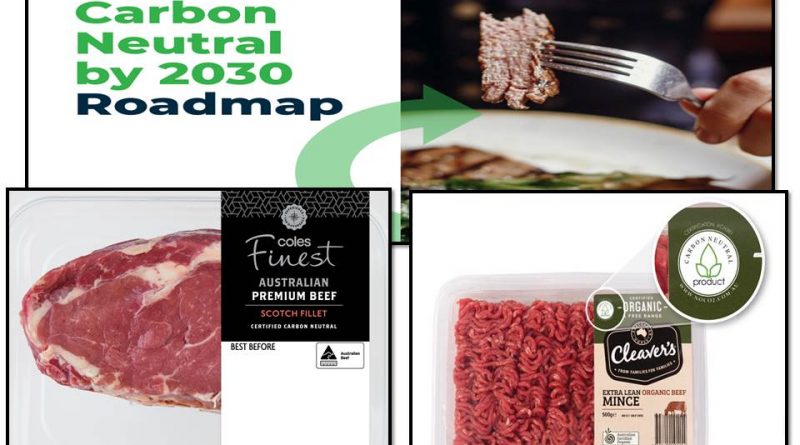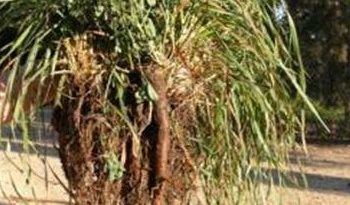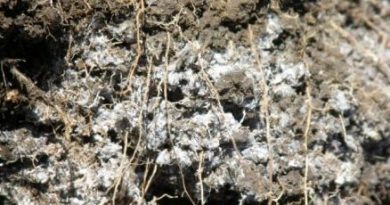Gap between soil carbon abatement science and trading credits growing wider
By Patrick Francis
There is increasing gap between the science behind soil organic carbon (SOC) sequestration potential and the opportunities for farmers to generate soil carbon credits via the Australian Government’s Emissions Reduction Fund “sequestering carbon in soils in grazing systems method” and into private carbon trading markets
The science contends that with best practice grazing and cropping management annual increase in SOC is low and short lived until a new equilibrium is reached but the associated soil organic matter (SOM) increase has highly beneficial continuous co-benefits for productivity and ecosystem functions. In contrast the Emission Reduction Fund and the private SOC markets portray soil carbon sequestration as a major new ongoing income source across many agricultural and pastoral districts as demand from corporations to offset their greenhouse gas emissions grows.
Two recently released publications based around soil organic carbon science highlight the growing gap between potential and reality in a topic complicated by government policy looking for as many opportunities as possible to meet carbon neutral targets up to 2050.
The Food and Agriculture Organisation’s (FAO) Global Soil Organic Carbon Sequestration Potential version 1.1 Technical Report provides encouraging support for the world’s farmers to counter climate change by using best practice methods to increase SOC.
It concludes: “Considering all global agricultural lands, the results suggest that SOC sequestration may play a relevant role in climate change mitigation: yearly agricultural global net emissions could be cut by up to 34 percent (between 2020 and 2040) by implementing practices oriented to increase C inputs. However, this also implies that, even without considering the technical, cultural and economic barriers to adopt sustainable soil management (SSM) practices in all the selected lands, SOC sequestration alone will not be enough to reduce agricultural net emissions to zero. It will be necessary to implement other practices oriented to reduce GHG net emissions from nutrient management, rice cultivation, manure management and enteric fermentation, among others.”
This conclusion was reached following assessment across most of world (not Australia) of three levels of annual carbon inputs compared to business as usual for cropping and grazing in all sort so environments. The input levels were:
* Low (SSM1): 5 percent increase in C inputs
• Medium (SSM2): 10 percent increase in C inputs
• High (SSM3): 20 percent increase in C inputs.
The results which highlight concern over optimistic Emissions Reduction Fund and private market soil carbon sequestration opportunities are the annual rates of sequestration at SSM 3, the highest annual percent increase in C inputs.
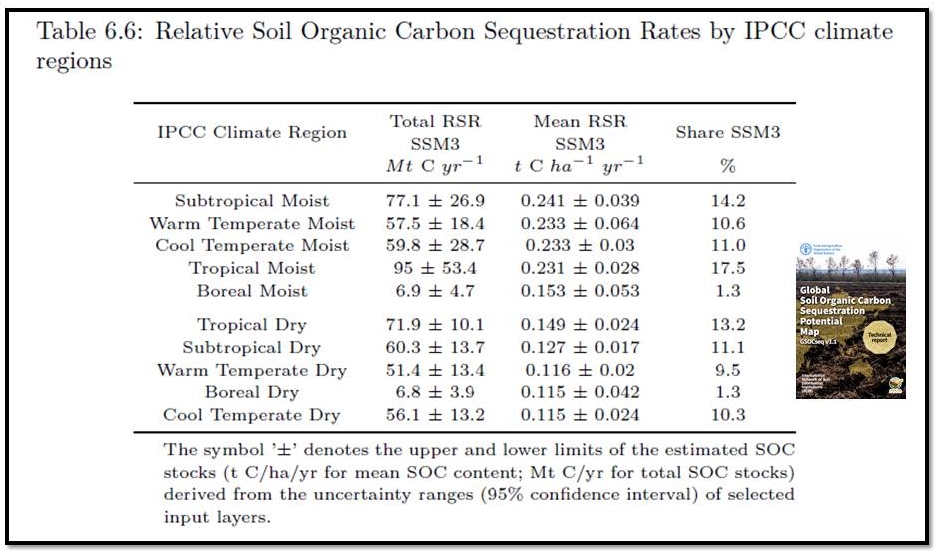
Table 6.6 shows the relative sequestration rates (RSR) across IPCC climate regions around the world. In terms of tonnes of C per hectare per years they range from 0.115 to 0.241.
When the land type variation is calculated, table 6.7, the RSR varies from 0.18 tonnes per hectare per year on cropping land to 0.30 t/ha/yr under tree crops.
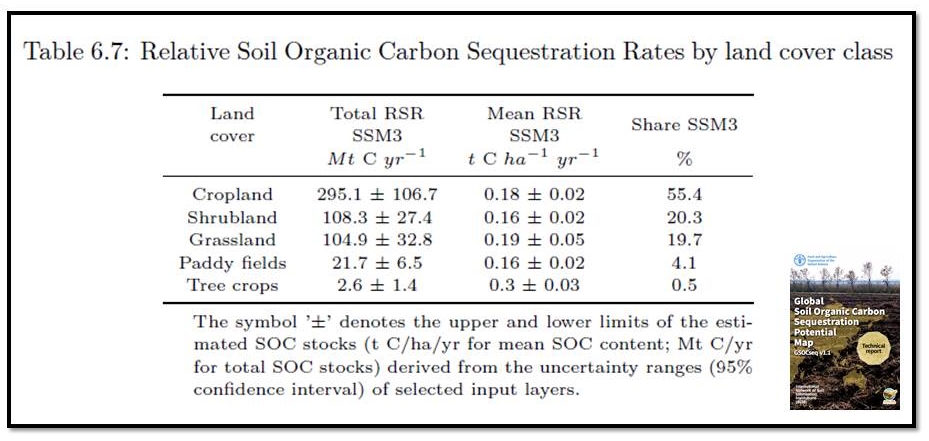
The striking thing about this data is the low annual sequestration rates and low variability irrespective of climate and land type. If these results are accurate they indicate that the small annual increases from the highest annual increases in carbon inputs mean trading SOC is likely to be high risk. The risk is made higher by the fact that the analysis doesn’t take into account natural phenomenon like droughts, floods, fires which could eliminate any gains made over the 20 year period covered by the report before SOC is equilibrium is likely to be achieved.
In its conclusion the FAO’s report makes no mention of trading soil organic carbon increases in any form. It is all about highlighting the co-benefit of increasing soil organic carbon as the means to combating climate change by mitigating agricultural emissions nationally and on a world scale. It emphasises that the need for a holistic approach across agriculture, processing and consumption of food to achieve greenhouse gas mitigation.
“Recent estimates show that transforming the complete land sector and deploying measures in agriculture, forestry, wetlands, bioenergy, diet shifts and food waste, could contribute about 30 percent of the global mitigation needed in 2050 to deliver on the 1.5 ◦C target from the Paris Agreement, stressing that no single strategy, sector or region will be sufficient to deliver on the mitigation objective. There are no single solutions to achieving GHG emission reductions and CO2 removal targets, and many strategies, each contributing a modest (5-10percent) part of the solution, will be required.”
Agriculture Victoria updates it SOC data
The second recent report which also highlights the importance to farming productivity and ecosystem services from increasing soil organic carbon (SOC) has been published by Agriculture Victoria. It is an update to “Soil Carbon Snapshot” first published in 2015. It reviews research undertaken into soil carbon since that time.
While not naming any particular sector interested in promoting increasing SOC for an alternative income source the report’s authors state early on”While maintaining or increasing soil carbon levels is a popular objective for many Australian farmers, we should also be mindful that in many situations this task will not be easy or without some fundamental shifts in understanding and land management practices.”
The report provides scientific information around all aspects of soil carbon including the functions of different fractions, implications for soil fertility and the role of the carbon to nitrogen ratio. Its coverage of why carbon sequestration requires nutrient inputs introduces readers to the degree of complexity involved which many advocates for carbon trading usually ignore.
“Building soil carbon stores is not easily achieved. Soil microbes need organic matter as their food source, and when conditions are suitable for microbial activity (e.g. warm & moist soils) much of the labile or particulate organic carbon is decomposed and released as carbon dioxide.”
On the other hand the stable portion of soil organic matter, humus (HOC), has a constant C:N:P:S ratio which means the relative proportions of each of these elements can limit the formation of carbon sequestered in the humus fraction.
“Thus, carbon sequestration can be limited by the supply of nutrients. Kirkby et al. estimated that each new tonne of soil carbon being created in the stable humus fraction would require or lock up 80kg nitrogen, 20kg phosphorus and 14kg sulphur. (They)estimated that at 2011 fertiliser prices this equated to a nutrient cost of $248 to build one new tonne of soil carbon in the humus portion. This has obvious ramifications for land managers when considering soil sequestration objectives, as the potential costs of any locked up nutrients could far outweigh potential income from carbon trading schemes. Irrespective of carbon trading aspirations, it is important to consider the implications for nutrients and crop production before embarking on soil carbon sequestration strategies.”
The issue of what components of soil carbon are actually being increased with changing farm management is seldom addressed in soil carbon trading discussion. Advocates of trading seem to base their optimistic scenarios around total SOC increases rather than HOC increases. This report highlights the folly of doing this.
“The amount of carbon in soil can be thought of as a leaking bucket that constantly needs topping up. The size of the bucket represents the total amount of carbon the soil could potentially hold. …. The changes in soil carbon fractions being added or lost is also an important consideration. Sanderman et al. (2010) noted that in studies where soil carbon stocks were found to be in equilibrium or increasing, the majority of the new carbon was found to have accumulated in the particulate organic carbon (POC) fraction, which has the shortest lifespan in soils and thus can be more easily lost.”
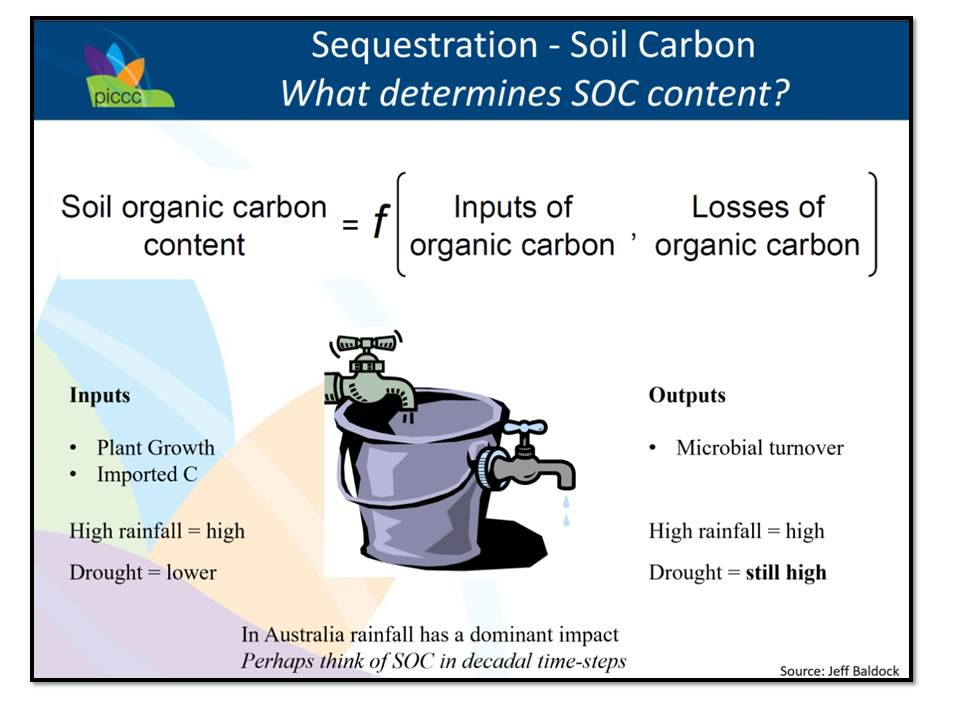
Figure 1A: Soil organic carbon change can be thought of as a bucket with two taps. The top tap controls flow of carbon via organic matter into the bucket and the bottom tap the exit of carbon out of the bucket as CO2 through microbial digestion. Source: Professor Richard Eckard webinar November 2021
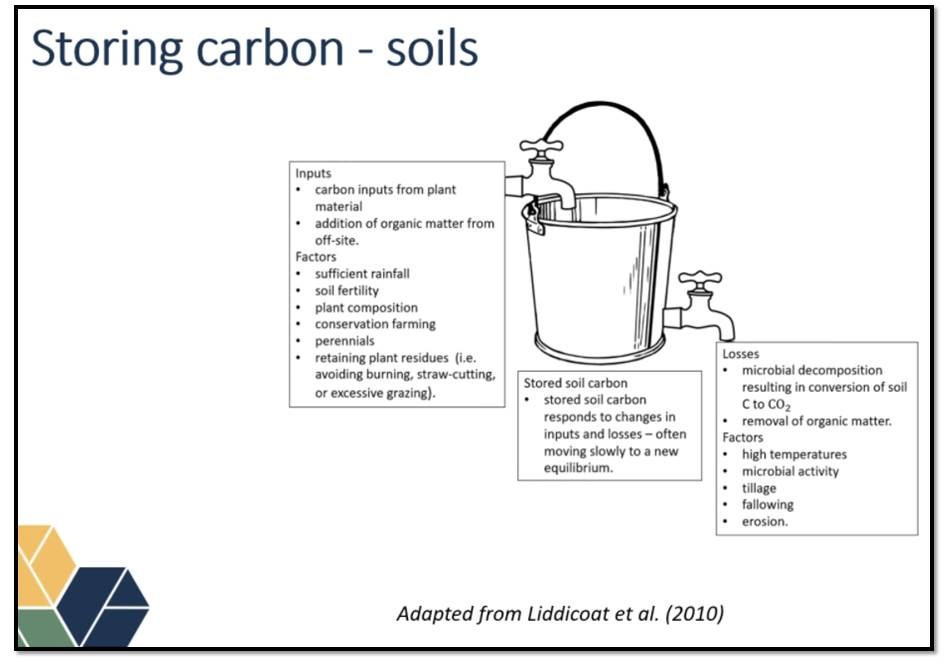
Figure 1B: Soil carbon inputs and losses according to Stephen Wiedemann, Integrity Ag & Environment webinar June 2022.
Just how fickle SOC can be was demonstrated in a 16 year study by Badgery et al (2020) “which showed unexpected increases in soil carbon in the first twelve years then fell and were reduced back to starting SOC levels in the following three years.” The SOC increase was mostly due to the particulate or labile component of SOC.
The scientists “…concluded that monitoring temporal changes in SOC over 12 years did not indicate long-term sequestration, such as that required to assure “permanence” in carbon trading schemes (25–100 years) due to the susceptibility of particulate organic carbon to degradation.”
The technical review by CSIRO, Roxburg et al. (2020) detailed a range of physical risks to carbon sequestration in Australia. “The dominant risks to sequestration for the management of agricultural soil activity, for both risks to accumulation and maintenance, were associated with climate change impacts on the rates of organic matter input to soil, and the rates of loss through changes to soil respiration and the microbial biota.”
The “Soil Carbon Snapshot” draws a critically important conclusion about SOC dynamics: “Overall, it is important to remember that it is the balance between the amount of plant biomass produced at a site, and the rate of decomposition that determines net changes to soil carbon. In many instances, increased organic matter production can be equally matched by increased rates of decomposition (leaking bucket), thus while there is more carbon ‘turnover’, the net carbon store in the soil will not have changed.”
The Snapshot refers to Sanderman et al. (2010) worldwide review of scientific studies into the impact of best practice management to sequester soil carbon which concluded there are opportunities to do so but annual increases are usually relatively small as shown in table 1 from former NSW soil scientist Dr Susan Orgill. The SOC measured in the scientific trials is total and not divided into its various components, particularly HOC which would provide an insight into its likely permanency as required to reduce risk in soil carbon trading commitments.
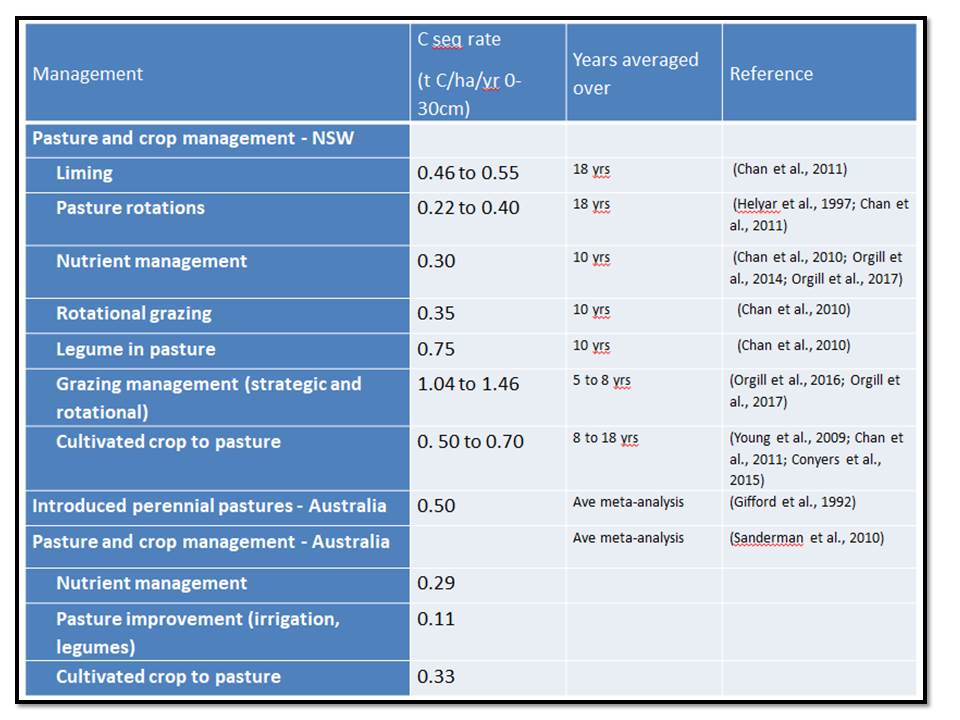
Table 1: Soil carbon sequestration rates in a range of scientific trials in southern Australia over the past 30 years. Source: Dr Susan Orgill, NSW DPI, webinar 2019.
Despite all the best practice management options adopted in the trials, which are the same ones advocated by the Emission Reduction Fund and proponents of soil carbon trading, the carbon sequestration rates are generally much less than 1 tonne of carbon/ha/yr averaging around 0.0 – 0.3 tonne carbon/ha/yr. Once again similar to the potential found in the FAO world report for best practice carbon inputs into soils across a range of land types and climates.

Table 2: Best practice management promoted under the Emissions Reduction Fund as eligible for a Soil Carbon in Grazing Systems project. At least one management activity must be new for the project area and “the soil carbon stored must be maintained until the end of the permanence period, which is 100 years for Carbon Farming Initiative projects and 25 or 100 years for Emissions Reduction Fund projects.” (EMF Guide to the sequestering carbon in soils in grazing systems method.)
Given such low annual soil carbon sequestration rates when best practice management is adopted Lam et al. (2013) noted that emerging carbon markets may not be financially attractive to farmers in many situations.
Despite the data and warning some private grazing management soil carbon trading has taken place, including the highly publicized NSW Wilmont Station sale to Microsoft. In an article in The Conversation (25 June 2021) written by nine eminent soil and agricultural scientists about this sale the point was made: “Wilmot increased soil carbon, or “sequestration”, through changes to grazing and pasture management. The resulting rates of carbon storage calculated by Regen Network were extremely high – 7,660 tonnes of carbon over 1,094 hectares (7tonnes per ha). This amounts to 7 tonnes of carbon per hectare from 2018 to 2019. These results are not consistent with our experience of what is possible through pasture management. For example, the CSIRO has documented soil carbon increases of 0.1 to 0.3 tonnes of carbon per hectare per year in Australia from a range of methods to increase pasture production. We believe inaccurate methods have led to the carbon increase being overestimated. Thus, it appears excess carbon credits may have been awarded.”
The CSIRO soil carbon increases for pasture land are in the same range as documented in the FAO’s Global Soil Organic Carbon Sequestration Potential May version 1.1 Technical Report across 19 countries.
Another example which highlights enormous rates of carbon storage in one year is provided by South Gippsland Vic, farmer Niels Olsen the inventor of the SoilKee pasture renovator. Its web site states “the Soilkee Renovator …builds soil carbon through carbon sequestration”. It cites an independent replicated trial over one year in nine rotationally grazed paddocks on three farms with pasture sown with the Renovator produced a soil carbon increase of 24%, from 3.7% to 4.6%.
Declan McDonald a soil scientist who supports using the Renovator noted in a series of webinars for soil carbon project developer AgriProve (who promotes Soilkee use) that to increase soil carbon by 1% the farmer need to add around 50 tonnes of dry matter per hectare to the soil. Scientific trials assessing dryland perennial pasture production over many years in medium rainfall districts (above 600mm) quote annual productivity at 8 to 20 tonnes dry matter per ha per year.
The soil carbon sequestration achieved on the Olsen farm became the “first carbon credits (ACCUs) issued to a soil carbon project under the Emissions Reduction Fund and the Paris Agreement”. Details about the permanence of the SOC increase achieved in one year on the Olsen farm have yet to be revealed. Could it be that depending on the farm location, soil type and climate the size of the SOC/SOM buckets vary widely but so do the flow rates of the input and output taps?
When it comes to management for likely permanent increase in SOC Sanderman et al (2010) noted more radical shifts are required. For instance, conversion of cropping land to permanent pasture, and retirement then restoration of degraded land.
But even taking this sort of management approach has its emissions implications. The Snapshot points out possible unintended consequences of changing management practice to improve SOC particularly if it involves increasing livestock numbers. “For example, changing from annual crops to permanent pastures may increase soil carbon, but it may also lead to an overall increase in total emissions when the additional ruminant livestock production (methane emissions) is also taken into account Meyer et al (2016).”
What to do
The Snapshot provides readers with a host of scientific evidence around best practice management for cropping and grazing which demonstrate a wide range of impacts on SOC, Table 2. The underlying message seems to be enormous variation in impacts with no definite conclusions except that as many methods as possible need to be undertaken concurrently to preserve and enhance soil organic matter irrespective of their impact on SOC.
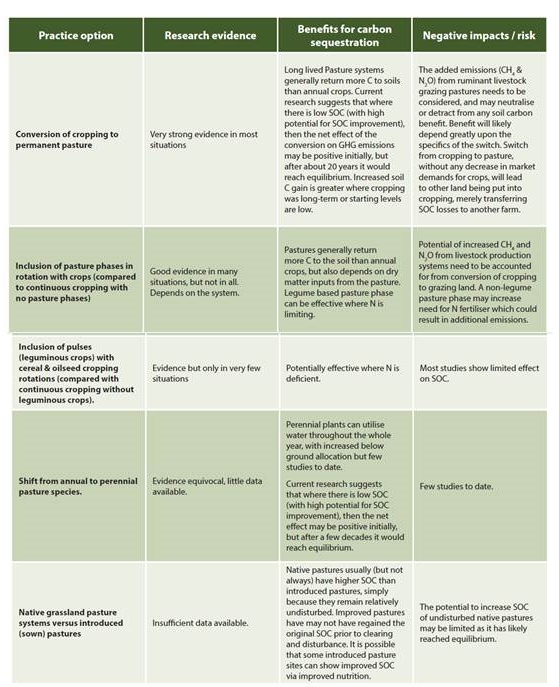
Table 2: Crop and pasture based practice options and evidence to maintain or increase soil organic matter and carbon.
In promoting different strategies to increase SOC in Table 2 the Snapshot fails to embrace the key importance of organic matter and the leaky bucket analogy in driving plant productivity and ecosystem functions. This omission may stem from the earlier reported fact that organic matter is mostly labile and decomposes and contributes little to soil carbon stocks.” The extent to which adding organic matter benefits SOC depends on the type, composition and amount of organic material applied.
Professor Richard Eckard draws the distinction between SOM and SOC in many of his presentations surrounding trading soil carbon credits. He points out that management to enhance SOM is what is likely to give the most financial benefit to farmers while improving across farm ecosystem functions and climate change resilience.

Figure 2: Professor Richard Eckard draws a distinction between Soil Organic Matter financial benefits and the challenges associated with building Soil Organic Carbon and subsequently trading it. Source: Richard Eckard webinar November 2021
The practical strategies omission in the Snapshot’s table 2 is the potential for building SOM and subsequently SOC in permanent perennial pasture zones. Much of southern Australia agricultural zone comprises permanent perennial pastures whose annual productivity is mostly dictated by rainfall. They have been under introduced (also referred to as “improved” or “exotic” species to differentiate them from native species) since the 1930’s when state departments of agriculture promoted their planting and began variety evaluations.
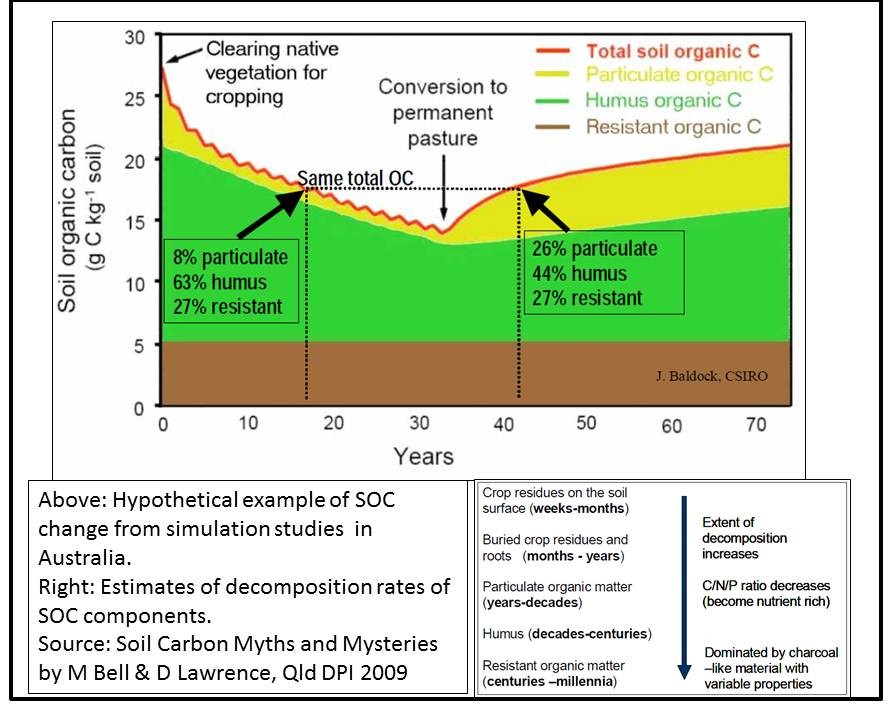
Figure 3 : This graphic depicting the fall and rise of soil organic carbon components is often referred to when discussing opportunities to build SOC “after clearing native vegetation for cropping”. The same diagram is not available for change in SOC in permanent pastures across both agricultural and pastoral where a cropping phase has never been undertaken. In such situations it is unlikely SOC has declined permanently as soil disturbance was minimal. So what are the impacts of grazing management, droughts, introducing new perennials and legumes, applying fertiliser on the different organic carbon components over decades?
Over the past 20 years there has been an upsurge in number of perennial grass and legume species available for planting with higher potential annual productivity, grazing resilience and seasonal growth habits than older introduced species. Their impacts on SOC and SOM levels do not seem to have been scientifically evaluated in the same way as it has been done for comparing the impacts of converting to perennial pastures from annual pastures, or from cropping to perennial pastures or from converting native pasture species paddock to introduced pasture species.
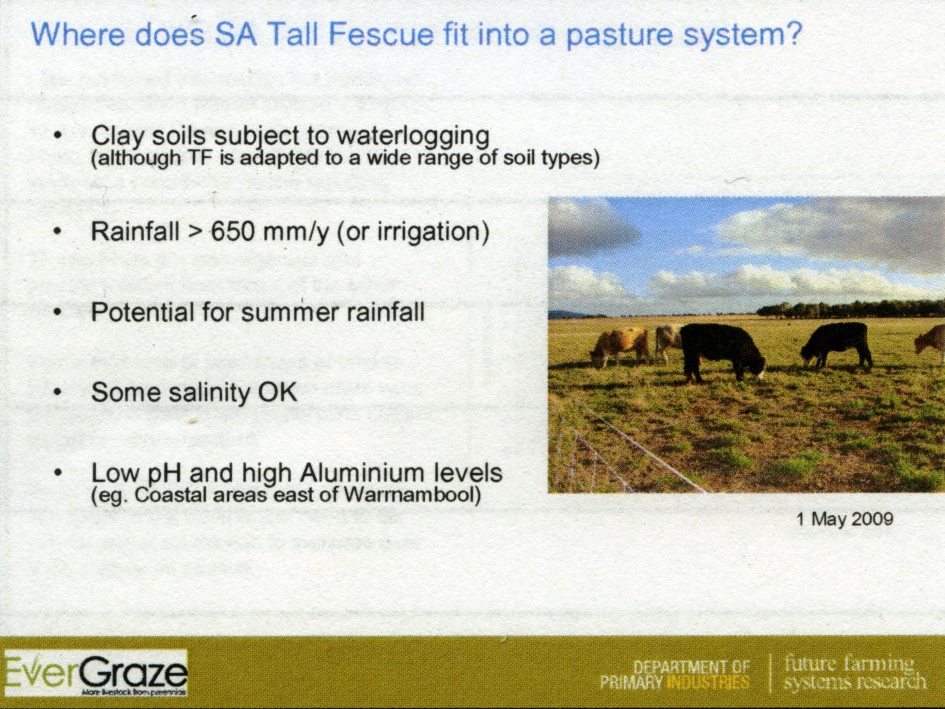
Figure 4: For at least the last 70 years farmers in the agricultural zone perennial pastures regions have been planting introduced species which are being continually improved by plant breeders to meet specific soil health, climate, grazing management and resilience (longevity) requirements. Source: EverGraze summer active (SA) tall fescue seminar Hamilton Victoria PVI February 2010.
Associated with pasture renovation programs is the impact on SOM and SOC of increasing legume species content in grass dominant pastures. This is becoming an important strategy for reducing ruminant livestock methane emissions both directly through lower ruminant methane production, higher animal growth rates and indirectly by reducing or even eliminating the need to use nitrogen fertiliser with its high manufacturing and in-soil global warming emissions.
Dewhurst R.J. et al 2009 explains why legumes reduce ruminant methane production: “The higher passage rate of legumes from the rumen restricts the opportunity for methanogens to colonise the feed substrate leading to reductions in CH4 production. Additionally higher digestibility and a faster rate of passage results in a shift toward high propionate production (an alternative hydrogen sink) in the rumen and reduced methane production”
The importance of adding legumes to perennial pastures with aim to maintain them at 30 t0 40% of total composition has been reviewed by Phelan P. et al 2014. Under the heading of life-cycle assessment and carbon footprint the authors state “Greenhouse gas emissions from agriculture are generally lower when biological N fixation is the source of N rather than fertilizer N.”
As well as farmers planting higher productivity perennials there are also more species choice around suitability for annual rainfall variability, for soil fertility level, for soil type and structure, and for grazing management applied. Does planting species for particular situations and productivity give a SOM and subsequently an SOC advantage over and above the long-term equilibrium achieved with older, low productivity introduced perennial grasses?
The Snapshot provides one clue to the answer which is derived from trials comparing carbon levels under native perennial grasses versus introduced perennial grasses. It reports: “If increased plant production is matched by an increase in organic matter decomposition, there will not be a net increase in soil carbon stocks.”
This reference to soil carbon stocks is the likely key to what seems to be confusion around building soil carbon. The general discussion around trading soil carbon misses the fundamental difference between carbon flows in soil and building stocks. As previously mentioned only humus can be counted on to build carbon stock, the stock build from organic matter is mostly labile carbon which last only a short time and needs constant replenishment via plant photosynthesis and livestock manure or fertilisers. The greater the flow of carbon into the soil by plant photosynthesis and harvesting of plant matter by livestock the greater the labile stock. But evidence suggests it doesn’t remain in the soil as a stock except in minute amounts as humus.
Evidence suggests the single Emissions Reduction Fund soil carbon credit project and private carbon market projects so far recorded have been relying on a build-up of carbon flow into the soil as organic matter, not a build-up of non-labile stocks.
Clean Energy Regulator’s view
The Australian Government’s Clean Energy Regulator’s Emission Reduction Fund soil carbon trading information guide neglects to mention the difference between increasing carbon flow in soil and building non-labile carbon stocks. In its publication “Participating in the Emissions Reduction Fund – A guide to the sequestering carbon in soils in grazing systems method” it defines a project as involving “…storing carbon on grazing land by introducing activities that either increase inputs of carbon to the soil, reduce losses of carbon from the soil or both. The carbon stored by the project is called stock.”
The regulator does not differentiate between soil carbon stock and flows so while a stock may be built from high carbon flow into soil that stock is mostly comprised on labile or temporary carbon as organic matter and is unlikely to meet the permanence requirement of 25 years or 100 years. Eckard’s bucket analysis figure 2A explains why.
The Clean Energy Regulator publication to guide farmers interested in developing a soil carbon trading project provides no scientific context to the issue of labile versus non labile stocks and their implications for trading the sum of both when permanence is necessary. It describes what Eckard portrays in figure 2, “Soil carbon stocks are a function of the balance between carbon inputs and losses. ….and there is no guarantee that any one of the management strategies (it lists) will build soil carbon on any particular property”.
For a Soil Carbon in Grazing Systems project to be accepted the Clean Energy Regulator is looking for evidence to be provided that the management actions “…have a reasonable chance of increasing carbon inputs into the soil”.
But not wishing to be seen as gilding the soil carbon trading lily, the Regulator states “Make sure you understand the need to maintain soil carbon stocks over the permanence period, with attendant financial and management consequences.”
In an article in the Farm Policy Journal May 2022 Professor David Panell, University of Western Australia Centre for Environmental Economics and Policy contends that the policy behind the Clean Energy Regulator’s Soil Carbon in Grazing Systems project has some important misgivings around permanence. The initial policy required soil carbon to be maintained for 100 years but that was so unattractive that farmers would not participate.
“In response, the Government reduced the requirement to 25 years and discounted farmers offset payments by 20%. After that time, farmers who have been paid to sequester carbon will be free to switch to a more profitable land use without penalty even if that results in the release of all the newly stored carbon. If the Australian Government wants the sequestered carbon to stay in the soil beyond that time, they will have to pay the farmers again,” Pannell states.
Pannell contends if all the deductions surrounding a Soil Carbon in Grazing Systems project are taken into account by the Emissions Reduction Fund “the result will be small payments to farmers – small relative to farmers’ other production costs and revenues. If the payments are not small (i.e. the deductions are not applied properly), then farmers will be receiving more money than can be justified by the contribution they are making to reducing climate change.”
“For the great majority of farmland, if an appropriately modest payment is offered, adopting a new practice that increases sequestration of soil carbon will either be too unprofitable for the payment to make a difference, or the new practice will already be profitable without the payment. In either of those cases, the availability of the payment would make no difference to farmers’ decisions about their land management.”
Pannell also make the point that advocated land management practices for a Soil Carbon in Grazing Systems project are already practiced by the majority of farmers, so the opportunities for further gains in those areas are low. “At least in Australia, much of the low-hanging fruit has already been picked”, he states.
“There is a danger that farmers are being misled into thinking that offset payments for soil-carbon sequestration will provide them with great financial opportunities. … If a soil-carbon offset program seems to be highly successful and supporting a lot of farmers, that should set off alarm bells. It probably means that insufficient deductions are being made (for emissions of methane or nitrous oxide, for impermanence and for the risk of reversal) or that most of the money is being paid for sequestration that would have happened without the payment”.
Pannell concludes that the government should stop issuing contracts for soil carbon in Emissions Reduction Fund. In its place he suggests:
* promoting the co-benefits for productivity, profitability, climate resilience, and ecosystem functions from increasing soil organic matter
* funding more research into emissions reduction, particularly methane from livestock which is the major greenhouse gas contributed by the agricultural sector.
Another eminent scientist has questioned the integrity of the ERF. Professor Andrew Macintosh, Australian National University co-authored a paper in April 2022 titled “The Emissions Reduction Fund: Problems and Solutions” which calls for an inquiry into the ERF. An inquiry was announced by the Federal government on 1 July 2022.
Macintosh makes the point in the article that: “While there is a need to balance integrity and efficiency, to the extent possible, ACCUs should represent 1 tonne of carbon dioxide equivalent (CO2-e) avoided or sequestered that would not otherwise occur. In shorthand, the abatement must be ‘real’ (there must be a reduction in emissions or increase in long- term sequestration) and ‘additional’ (it must not have been likely to occur anyway).
“Under the Carbon Credits (Carbon Farming Initiative) Act 2011 (CFI Act), all offset methods are supposed to meet six offsets integrity standards that are intended to ensure the integrity of the credited abatement. These standards include that the projects covered by the methods should result in abatement that is ‘unlikely to occur in the ordinary course of business’, the methods should be ‘supported by clear and convincing evidence’, and the estimates, projections and assumptions in the methods ‘should be conservative’. The need for methods to be assessed against these standards is intended to ensure the abatement that is credited is real and additional.”
Can’t have your SOC abatement and trade it to
Apart from the soil science issues around building SOC versus the optimism for doing so coming from the Clean Energy Regulator and commercial carbon project businesses is the important reality that the food and fibre industry is looking to its suppliers to become carbon/climate neutral. This means that if farmers can build carbon stocks on a permanent basis across their farms then they must be retained to justify being part of a supply chain that can guarantee food and fibre consumers that the products are on the road to carbon neutrality or have achieved it.
Dr Cassandra Schefe, project lead for the AgriSci Cool Soil Initiative highlighted this point in a webinar in November 2021 by referring to “carbon for systems or carbon for sale”. She said pressure is building on farmers to demonstrate ‘carbon neutrality’ or a negative carbon footprint in order to sell commodities into various markets both domestic and overseas. “This means that rather than sell (carbon) credits to third parties it may become attractive for farmers to retain these to offset their own system emissions.
“A farmer cannot sell a carbon credit to a third party (ACCU or voluntary market) and then also report on their emission footprint (and reductions in that footprint) through their supply chain. This is considered to be double-dipping against the same bank of soil carbon and production related emissions”.

